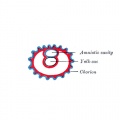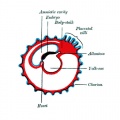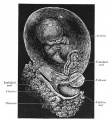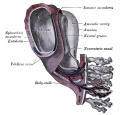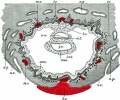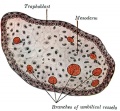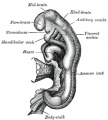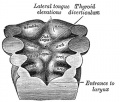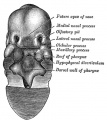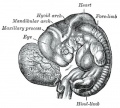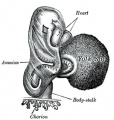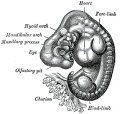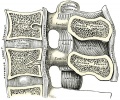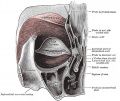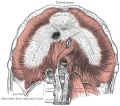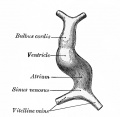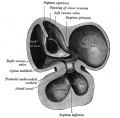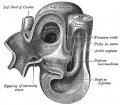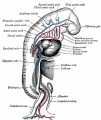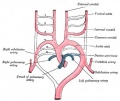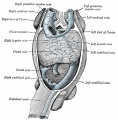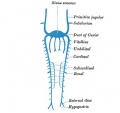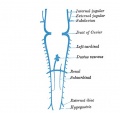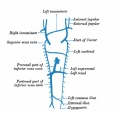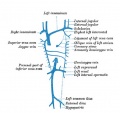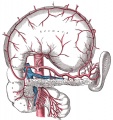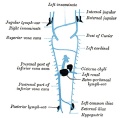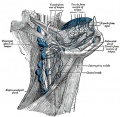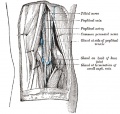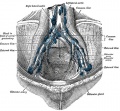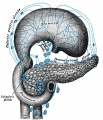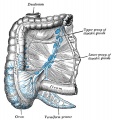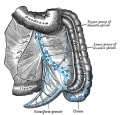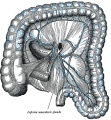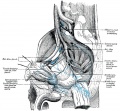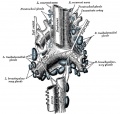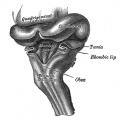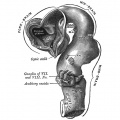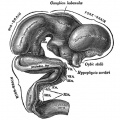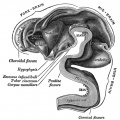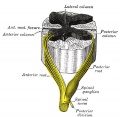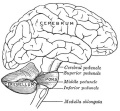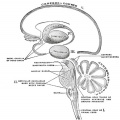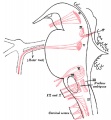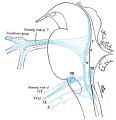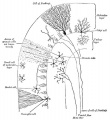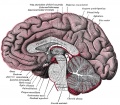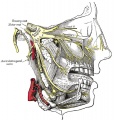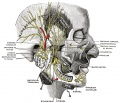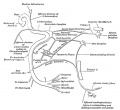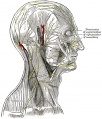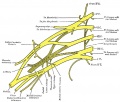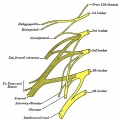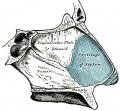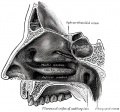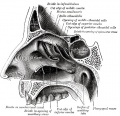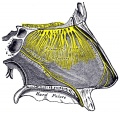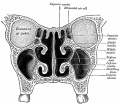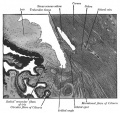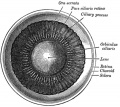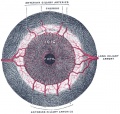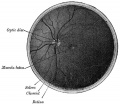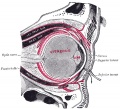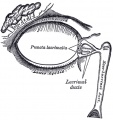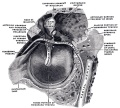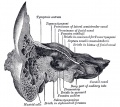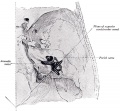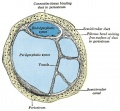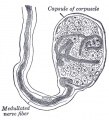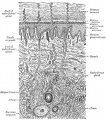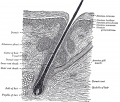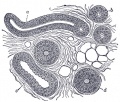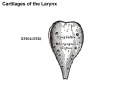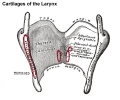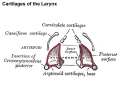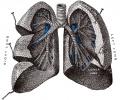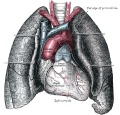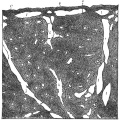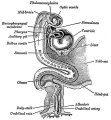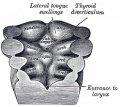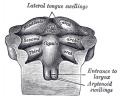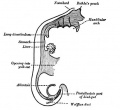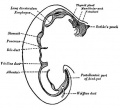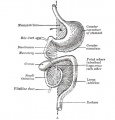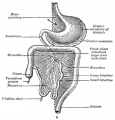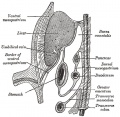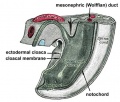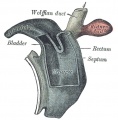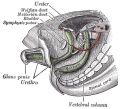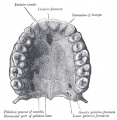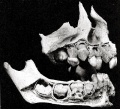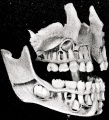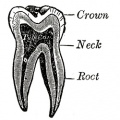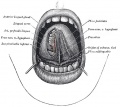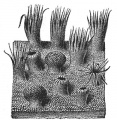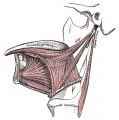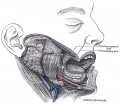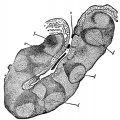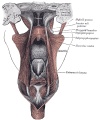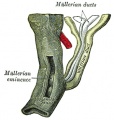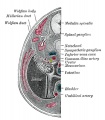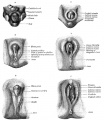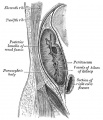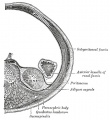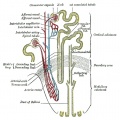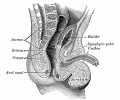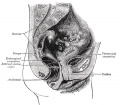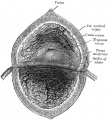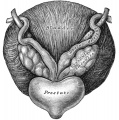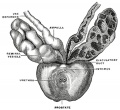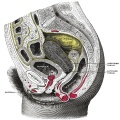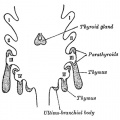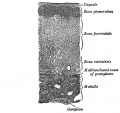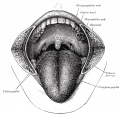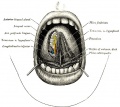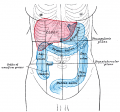Anatomy of the Human Body by Henry Gray: Difference between revisions
mNo edit summary |
|||
| (174 intermediate revisions by the same user not shown) | |||
| Line 1: | Line 1: | ||
{{Header}} | |||
{{Ref-Gray1918}} | |||
{{Historic Disclaimer}} | |||
==Introduction== | ==Introduction== | ||
[[File:Gray_1918.jpg|thumb]] | [[File:Gray_1918.jpg|thumb]] | ||
| Line 5: | Line 9: | ||
Classic anatomy textbook widely reproduced online, particularly the anatomical illustrations, due to the fact that the 1918 edition is out of copyright. W.H. Lewis edited the 20th edition published in September 1918, the current 40th edition was published in 2008. The majority of images were anatomical drawings with some cartoon simplifications. The text also includes earlier historic drawings, particularly in the embryology section that commences the text. | Classic anatomy textbook widely reproduced online, particularly the anatomical illustrations, due to the fact that the 1918 edition is out of copyright. W.H. Lewis edited the 20th edition published in September 1918, the current 40th edition was published in 2008. The majority of images were anatomical drawings with some cartoon simplifications. The text also includes earlier historic drawings, particularly in the embryology section that commences the text. | ||
Clicking the [[:Category:Gray's 1918 Anatomy|Category:Gray's 1918 Anatomy]] should display a list of the images available on this current website. Note that over time the image naming has varied and requires better standardisation. Images used here may be altered and edited from those appearing in the original textbook. | Clicking the [[:Category:Gray's 1918 Anatomy|Category:Gray's 1918 Anatomy]] should display a list of the images available on this current website. Note that over time the image naming has varied and requires better standardisation. Images used here may be altered and edited from those appearing in the original textbook. | ||
| Line 13: | Line 16: | ||
{| | {| | ||
| [[File: | | [[File:IBooks_icon.jpg|100px]] | ||
| '''iBooks''' | | '''iBooks''' | ||
| Line 19: | Line 22: | ||
|} | |} | ||
{{Grays Embryo iBook table}} | |||
ANATOMY OF THE HUMAN BODY | |||
==Textbook Introduction== | |||
THE term human anatomy comprises a consideration of the various structures which make up the human organism. In a restricted sense it deals merely with the parts which form the fully developed individual and which can be rendered evident to the naked eye by various methods of dissection. Regarded from such a standpoint it may be studied by two methods: (1) the various structures may be separately considered— systematic anatomy; or (2) the organs and tissues may be studied in relation to one another — topographical or regional anatomy. | |||
It is, however, of much advantage to add to the facts ascertained by nakedeye dissection those obtained by the use of the microscope. This introduces two fields of investigation, viz., the study of the minute structure of the various component parts of the body — histology — and the study of the human organism in its immature condition, i. e., the various stages of its intrauterine development from the fertilized ovum up to the period when it assumes an independent existence — embryology. Owing to the difficulty of obtaining material illustrating all the stages of this early development, gaps must be filled up by observations on the development of lower forms — comparative embryology, or by a consideration of adult forms in the line of human ancestry — comparative anatomy. The direct application of the facts of human anatomy to the various pathological conditions which may occur constitutes the subject of applied anatomy. Finally, the appreciation of structures on or immediately underlying the surface of the body is frequently made the subject of special study — smiace anatomy. | |||
===Systematic Anatomy=== | |||
The various systems of which the human body is composed are grouped under the following headings: | |||
# Osteology — the bony system or skeleton. | |||
# Syndesmology — the articulations or joints. | |||
# Myology — the muscles. With the description of the muscles it is convenient to include that of the fasciae which are so intimately connected with them. | |||
# Angiology — the vascular system, comprising the heart, bloodvessels, lymphatic vessels, and lymph glands. | |||
# Neurology — the nervous system. The organs of sense may be included in this system. | |||
# Splanchnology — the visceral system. Topographically the viscera form two groups, viz., the thoracic viscera and the abdomino-pelvic viscera. The heart, a thoracic viscus, is best considered with the vascular system. The rest of the viscera may be grouped according to their functions: (a) the respiratory apparatus; (6) the digestive apparatus; and (c) the urogenital apparatus. Strictly speaking, the third subgroup should include only such components of the urogenital apparatus as are included within the abdomino-pelvic cavity, but it is convenient to study under this heading certain parts which lie in relation to the surface of the body, e. g., the testes and the external organs of generation. | |||
For descriptive purposes. the body is supposed to be in the erect posture, with the arms hanging by the sides and the palms of the hands directed forward. The median plane is a vertical antero-posterior plane, passing through the center of the trunk. This plane will pass approximately through the sagittal suture of the skull, and hence any plane parallel to it is termed a sagittal plane. A vertical plane at right angles to the median plane passes, roughly speaking, through the central part of the coronal suture or through a line parallel to it; such a plane is known as a frontal plane or sometimes as a coronal plane. A plane at right angles to both the median and frontal planes is termed a transverse plane. | |||
The terms anterior or ventral, and posterior or dorsal, are employed to indicate the relation of parts to the front or back of the body or limbs, and the terms superior or cephalic, and inferior or caudal, to indicate the relative levels of different structures; structures nearer to or farther from the median plane are referred to as medial or lateral respectively. | |||
The terms superficial and deep are strictly confined to descriptions of the relative depth from the surface of the various structures; external and internal are reserved almost entirely for describing the walls of cavities or of hollow viscera. In the case of the limbs the words proximal and distal refer to the relative distance from the attached end of the limb. | |||
===Embryology=== | |||
THE term Embryology, in its widest sense, is applied to the various changes which take place during the growth of an animal from the egg to the adult condition: it is, however, usually restricted to the phenomena which occur before birth. Embryology may be studied from two aspects: | |||
# that of ontogeny, which deals only with the development of the individual; | |||
# that of phylogeny, which concerns itself with the evolutionary history of the animal kingdom. | |||
In vertebrate animals the development of a new being can only take place when a female germ cell or ovum has been fertilized by a male germ cell or spermatozoon. The ovum is a nucleated cell, and all the complicated changes by which the various tissues and organs of the body are formed from it, after it has been fertilized, are the result of two general processes, viz., segmentation and differentiation of cells. Thus, the fertilized ovum undergoes repeated segmentation into a number of cells which at first closely resemble one another, but are, sooner or later, differentiated into two groups: (1) somatic cells, the function of which is to build up the various tissues of the body; and (2) germinal cells, which become imbedded in the sexual glands — the ovaries in the female and the testes in the male — and are destined for the perpetuation of the species. | |||
Having regard to the main purpose of this work, it is impossible, in the space available in this section, to describe fully, or illustrate adequately, all the phenomena which occur in the different stages of the development of the human body. Only the principal facts are given, and the student is referred for further detaUs to one or other of the text-books^ on human embryology. | |||
Not all site images are included below. There may be several image versions (sizes, labeling, and formats gif, jpg, png). | Not all site images are included below. There may be several image versions (sizes, labeling, and formats gif, jpg, png). | ||
== | {{Historic Disclaimer}} | ||
==Development== | |||
<gallery> | <gallery> | ||
File:Gray0015.jpg|Neural Groove- series of sections dog embryo | File:Gray0015.jpg|15 Neural Groove- series of sections {{dog}} embryo | ||
File:Gray0020.jpg|Dorsal human embryo 2.11 mm | File:Gray0020.jpg|20 Dorsal human embryo 2.11 mm | ||
File:Gray0024. | File:Gray0024.jpg|24 Diagram showing earliest observed stage of human ovum | ||
File:Gray0025. | File:Gray0025.jpg|25 Diagram illustrating early formation of allantois and differentiation of body-stalk | ||
File:Gray0026. | File:Gray0026.jpg|26 Diagram showing later stage of allantoic development with commencing constriction of the yolk-sac | ||
File:Gray0027. | File:Gray0027.jpg|27 Diagram showing the expansion of amnion and delimitation of the umbilicus | ||
File:Gray0031.jpg|Model of human embryo 1.3 mm | File:Gray0028.jpg|28 Diagram illustrating a later stage in the development of the umbilical cord | ||
File:Gray0032.jpg|Human Embryo Day 8 to 9 (week 3) | File:Gray0029.jpg|29 Diagram of a transverse section, showing the mode of formation of the amnion in the chick. | ||
File:Gray0034.jpg|Uterus in the third and fourth month | File:Gray0030.jpg|30 Fetus of about eight weeks, enclosed in the amnion. | ||
File:Gray0036.jpg|Primary Chorionic Villi | File:Gray0031.jpg|31 Model of human embryo 1.3 mm | ||
File:Gray0037.jpg|Secondary Chorionic Villi | File:Gray0032.jpg|32 Human Embryo Day 8 to 9 (week 3) | ||
File:Gray0038.jpg|Fetus in Utero Between fifth and sixth months | File:Gray0033.jpg|33 Non-pregnant and pregnant uterus | ||
File:Gray0039.jpg|Placental circulation | File:Gray0034.jpg|34 Uterus in the third and fourth month | ||
File:Gray0040.jpg| | File:Gray0035.jpg|35 Transverse section of a chorionic villus | ||
File:Gray0052.jpg| | File:Gray0036.jpg|36 Primary Chorionic Villi | ||
File:Gray0053.jpg| | File:Gray0037.jpg|37 Secondary Chorionic Villi | ||
File:Gray0058.jpg| | File:Gray0038.jpg|38 Fetus in Utero Between fifth and sixth months | ||
File:Gray0060.jpg| | File:Gray0039.jpg|39 Placental circulation | ||
File:Gray0063.jpg| | File:Gray0040.jpg|40 | ||
File:Gray0065.jpg| | File:Gray0041.jpg|41 Head end of human embryo about the end of the fourth week | ||
File:Gray0082.jpg| | File:Gray0042.jpg|42 Floor of Pharynx | ||
File:Gray0043.jpg|43 Head and neck of a human embryo eighteen weeks old with Meckel’s cartilage and hyoid bar exposed | |||
File:Gray0044.jpg|44 Under surface of the head of a human embryo about twenty-nine days old | |||
File:Gray0045.jpg|45 | |||
File:Gray0046.jpg|46 | |||
File:Gray0047.jpg|47 Head of a human embryo of about eight weeks | |||
File:Gray0048.jpg|48 Diagram showing the regions of the adult face and neck related to the fronto-nasal process and the branchial arches | |||
File:Gray0049.jpg|49 Primitive palate of a human embryo of thirty-seven to thirty-eight days | |||
File:Gray0050.jpg|50 The roof of the mouth of a human embryo aged about two and a half months | |||
File:Gray0051.jpg|51 Frontal section of nasal cavities of a human embryo 28 mm long | |||
File:Gray0052.jpg|52 | |||
File:Gray0053.jpg|53 | |||
File:Gray0058.jpg|58 | |||
File:Gray0060.jpg|60 | |||
File:Gray0063.jpg|63 | |||
File:Gray0065.jpg|65 | |||
File:Gray0082.jpg|83 | |||
</gallery> | </gallery> | ||
<gallery> | <gallery> | ||
File:Gray0101.jpg|101 | |||
File:Gray0118.jpg|118 | |||
File:Gray0119.jpg|119 | |||
File:Gray0130.jpg|130 Human occipital bone, inner surface. | |||
File:Gray0176.jpg|176 Human adult mandible | |||
File:Gray0178.jpg|178 Human embryo CRL 24 mm outer aspect | |||
File:Gray0179.jpg|179 Human embryo CRL 24 mm inner aspect | |||
File:Gray0180.jpg|180 Human embryo CRL 95 mm outer aspect | |||
File:Gray0181.jpg|181 Human embryo CRL 95 mm inner aspect | |||
File:Gray0182.jpg|182 Mandible at birth | |||
File:Gray0183.jpg|183 Mandible in childhood | |||
File:Gray0184.jpg|184 Mandible adult | |||
File:Gray0185.jpg|185 Mandible at old age | |||
File:Gray0193.jpg|193 Base of the skull | |||
</gallery> | </gallery> | ||
===301-400=== | ===301-400=== | ||
<gallery> | <gallery> | ||
File:Gray0301.jpg| | File:Gray0301.jpg|301 | ||
File:Gray0321.jpg| | File:Gray0321.jpg|321 Symphysis pubis exposed by a coronal section | ||
File:Gray0391.jpg|Adult human diaphragm (viewed from beneath) | File:Gray0379.jpg|379 Left orbicularis oculi (seen from behind) | ||
File:Gray0391.jpg|391 Adult human diaphragm (viewed from beneath) | |||
</gallery> | </gallery> | ||
===401-500 | ==Cardiovascular== | ||
401-500 | |||
<gallery> | <gallery> | ||
File:Gray0448.jpg|Artery and vein | File:Gray0448.jpg|448 Artery and vein | ||
File:Gray0458. | File:Gray0458.jpg|458 Diagram of the vascular channels in a human embryo of the second week | ||
File:Gray0462. | File:Gray0459.jpg|459 Human embryo of about fourteen days, with yolk-sac | ||
File:Gray0464. | File:Gray0460.jpg|460 Head of chick embryo of about thirty-eight hours' incubation | ||
File:Gray0467.jpg| | File:Gray0461.jpg|461 Diagram to illustrate the simple tubular condition of the heart | ||
File:Gray0468.jpg| | File:Gray0462.jpg|462 Heart of human embryo of about fourteen days | ||
File:Gray0470.jpg| | File:Gray0463.jpg|463 Heart of human embryo of about fifteen days | ||
File:Gray0472.jpg| | File:Gray0464.jpg|464 Dorsal surface of heart of human embryo of thirty-five days | ||
File:Gray0473. | File:Gray0465.jpg|465 Interior of dorsal half of heart from a human embryo of about thirty days | ||
File:Gray0474.jpg| | File:Gray0467.jpg|467 | ||
File:Gray0475.jpg| | File:Gray0468.jpg|468 | ||
File:Gray0476.jpg| | File:Gray0470.jpg|470 | ||
File:Gray0477.jpg| | File:Gray0472.jpg|472 | ||
File:Gray0478.jpg| | File:Gray0473.jpg|473 | ||
File:Gray0479.jpg| | File:Gray0474.jpg|474 | ||
File:Gray0480.jpg| | File:Gray0475.jpg|475 | ||
File:Gray0492.jpg| | File:Gray0476.jpg|476 | ||
File:Gray0498.jpg| | File:Gray0477.jpg|477 | ||
File:Gray0478.jpg|478 | |||
File:Gray0479.jpg|479 | |||
File:Gray0480.jpg|480 | |||
File:Gray0492.jpg|492 | |||
File:Gray0498.jpg|498 | |||
File:Gray0502.jpg|502 | |||
File:Gray0506.jpg|506 | |||
File:Gray0532.jpg|532 The celiac artery and its branches. | |||
File:Gray0533.jpg|533 The celiac artery and its branches. | |||
File:Gray0540.jpg|540 | |||
File:Gray0556.jpg|556 | |||
File:Gray0589.jpg|589 Vessels of the uterus and its appendages. | |||
</gallery> | </gallery> | ||
==Lymphatic== | |||
592 | |||
[[Immune System Development]] | |||
<gallery> | <gallery> | ||
File: | File:Gray0592.jpg|592 Primary lymph sacs. | ||
File: | File:Gray0593.jpg|593 Lymph capillaries of the human conjunctiva. | ||
File: | File:Gray0594.jpg|594 Lymph capillaries from the human scrotum. | ||
File: | File:Gray0595.jpg|595 Lymph capillaries of the sole of the human foot. | ||
File: | File:Gray0596.jpg|596 Section through human tongue. | ||
File: | File:Gray0597.jpg|597 Lymph gland (Node). | ||
File:Gray0598.jpg|598 Lymph gland tissue. | |||
File:Gray0599.jpg|599 Thoracic and right lymphatic ducts. | |||
File:Gray0600.jpg|600 Modes of origin of thoracic duct. | |||
File:Gray0601.jpg|601 Terminal collecting trunks of right side. | |||
File:Gray0602.jpg|602 Lymph glands of the head. | |||
File:Gray0603.jpg|603 Lymphatics of pharynx. | |||
File:Gray0604.jpg|604 Lymphatics of the face. | |||
File:Gray0605.jpg|605 Lymphatics of the Tongue. | |||
File:Gray0606.jpg|606 Lymph glands of the upper extremity. | |||
File:Gray0607.jpg|607 Lymphatics of the mamma. | |||
File:Gray0608.jpg|608 Lymphatic vessels of the dorsal hand surface. | |||
File:Gray0609.jpg|609 Lymph glands of popliteal fossa. | |||
File:Gray0610.jpg|610 Superficial lymph glands and vessels of the lower extremity. | |||
File:Gray0611.jpg|611 Parietal lymph glands of the pelvis. | |||
File:Gray0612.jpg|612 Iliopelvic glands. | |||
File:Gray0613.jpg|613 Lymphatics of stomach. | |||
File:Gray0614.jpg|614 Lymphatics of stomach. | |||
File:Gray0615.jpg|615 Lymphatics of cecum and vermiform process. | |||
File:Gray0616.jpg|616 Lymphatics of cecum and vermiform process. | |||
File:Gray0617.jpg|617 Lymphatics of Colon. | |||
File:Gray0618.jpg|618 Lymphatic of the Bladder. | |||
File:Gray0619.jpg|619 Lymphatics of the Prostate. | |||
File:Gray0620.jpg|620 Lymphatics of the Uterus. | |||
File:Gray0621.jpg|621 Lymphatics of the thorax and abdomen. | |||
File:Gray0622.jpg|622 Tracheobronchial Lymph Glands | |||
</gallery> | </gallery> | ||
== | ==Neural== | ||
623 | |||
<gallery> | <gallery> | ||
File:Gray0649.jpg|Human Fetal Hindbrain (3 months) | File:Gray0623.jpg|623 Neuroglia cells of brain. | ||
File:Gray0651.jpg|Human Embryo Brain (week 4.5 exterior view) | File:Gray0649.jpg|649 Human Fetal Hindbrain (3 months) | ||
File:Gray0652.jpg|Human Embryo Brain (week 5 exterior view) | File:Gray0651.jpg|651 Human Embryo Brain (week 4.5 exterior view) | ||
File:Gray0653.jpg|Human Embryo Brain (week 5 interior view) | File:Gray0652.jpg|652 Human Embryo Brain (week 5 exterior view) | ||
File:Gray0654.jpg|Human Fetal Brain (3 months) | File:Gray0653.jpg|653 Human Embryo Brain (week 5 interior view) | ||
File:Gray0655.jpg|Human Fetal Brain (4 months) | File:Gray0654.jpg|654 Human Fetal Brain (3 months) | ||
File:Gray0658.jpg|Human Fetal Brain (5 months) | File:Gray0655.jpg|655 Human Fetal Brain (4 months) | ||
File:Gray0677.jpg| | File:Gray0658.jpg|658 Human Fetal Brain (5 months) | ||
File:Gray0678.jpg| | File:Gray0664.jpg|664 Transverse section of the medulla spinalis in the mid-thoracic region | ||
File:Gray0697.jpg| | File:Gray0666.jpg|666 Transverse sections of the medulla spinalis at different levels | ||
File:Gray0698.jpg| | File:Gray0666.jpg|666 (new layout) Transverse sections of the medulla spinalis at different levels | ||
File:Gray0670.jpg|670 Diagram showing afferent (sensory) and efferent fibers | |||
File:Gray0671.jpg|671 Spinal cord motor columns | |||
File:Gray0675.jpg|675 A spinal nerve with its anterior and posterior roots | |||
File:Gray0677.jpg|677 | |||
File:Gray0678.jpg|678 | |||
File:Gray0697.jpg|697 | |||
File:Gray0698.jpg|698 | |||
File:Gray0702.jpg|702 | |||
File:Gray0704.jpg|704 | |||
File:Gray0705.jpg|705 | |||
File:Gray0706.jpg|706 | |||
File:Gray0708.jpg|708 | |||
File:Gray0715.jpg|715 | |||
File:Gray0720.jpg|720 Median sagittal section of brain | |||
File:Gray0732.jpg|732 | |||
File:Gray0769.jpg|769 Section across the top of the skull | |||
File:Gray0770.jpg|770 Transverse section of medulla spinalis and its membranes | |||
File:Gray0778.jpg|778 Distribution of the maxillary and mandibular nerves, and the submaxillary ganglion | |||
File:Gray0781.jpg|781 Mandibular division of the Trigeminal Nerve | |||
File:Gray0784.jpg|784 Sensory areas of the head | |||
File:Gray0786.jpg|786 Oblique section through the right cavernous sinus | |||
File:Gray0788.jpg|788 Plan of the Facial and Intermediate Nerves and their Communication with Other Nerves | |||
File:Gray0790.jpg|790 The nerves of the scalp face and side of neck | |||
File:Gray0804.jpg|804 Cervical Plexus | |||
File:Gray0806.jpg|806 | |||
File:Gray0807.jpg|807 Branchial Plexus | |||
File:Gray0822.jpg|822 Lumbar Plexus | |||
</gallery> | </gallery> | ||
== | ==Smell== | ||
852 | |||
<gallery> | <gallery> | ||
File: | File:Gray0852.jpg|852 Cartilages of the nose Side view | ||
File: | File:Gray0853.jpg|853 Cartilages of the nose, seen from below | ||
File: | File:Gray0854.jpg|854 Bones and cartilages of septum of nose Right side | ||
File: | File:Gray0855.jpg|855 Lateral wall of nasal cavity | ||
File: | File:Gray0856.jpg|856 | ||
File: | File:Gray0857.jpg|857 | ||
File: | File:Gray0858.jpg|858 | ||
File: | File:Gray0859.jpg|859 Coronal section of nasal cavities | ||
File:Gray0860.jpg| | |||
File:Gray0861.jpg| | |||
File:Gray0862.jpg| | |||
</gallery> | </gallery> | ||
=== | ==Vision== | ||
<gallery> | |||
File:Gray0863.jpg|863 Chicken Optic Placode and Vesicle | |||
File:Gray0864.jpg|864 Chicken Optic Placode and Vesicle | |||
File:Gray0865.jpg|865 Human Optic Cup and Choroidal Fissure | |||
File:Gray0866.jpg|866 Embryonic Rabbit Eye | |||
File:Gray0867.jpg|867 Human Embryonic Eye | |||
File:Gray0868.jpg|868 Section of developing eye of trout | |||
File:Gray0869.jpg|869 Horizontal section of the eyeball | |||
File:Gray0870.jpg|870 Cornea | |||
File:Gray0871.jpg|871 Section of Human Cornea near the Margin | |||
File:Gray0872.jpg|872 The Choroid and Iris | |||
File:Gray0873.jpg|873 The Arteries of the Choroid and Iris | |||
File:Gray0874.jpg|874 The Veins of the Choroid | |||
File:Gray0875.jpg|875 Interior of anterior half of bulb of eye | |||
File:Gray0876.jpg|876 Vessels of the choroid, ciliary processes, and iris of a child | |||
File:Gray0877.jpg|877 Blood Vessels of the Eye | |||
File:Gray0878.jpg|878 Iris front view | |||
File:Gray0879.jpg|879 Interior of posterior half of bulb of left eye | |||
File:Gray0880.jpg|880 Optic Nerve entering Eyeball | |||
File:Gray0881.jpg|881 Section of Retina | |||
File:Gray0882.jpg|882 Plan of Retinal Neurons | |||
File:Gray0883.jpg|883 Section through front of Eyeball | |||
File:Gray0884.jpg|884 Lens Structure | |||
File:Gray0885.jpg|885 Lens | |||
File:Gray0886.jpg|886 Lens Profile | |||
File:Gray0887.jpg|887 Lens Epithelium | |||
File:Gray0888.jpg|888 Sagittal section of right orbital cavity | |||
File:Gray0889.jpg|889 Muscles of the right orbit | |||
File:Gray0890.jpg|890 Right Ocular Muscles | |||
File:Gray0891.jpg|891 Right Eye Fascia Bulbi | |||
File:Gray0892.jpg|892 Front of left eye with eyelids separated to show medial canthus | |||
File:Gray0893.jpg|893 Structure of the Eyelids | |||
File:Gray0894.jpg|894 The tarsi and their ligaments | |||
File:Gray0895.jpg|895 The Tarsal Glands | |||
File:Gray0896.jpg|896 The Lacrimal Gland | |||
File:Gray0897.jpg|897 Structures of the Lacrimal Gland | |||
</gallery> | |||
==Hearing== | |||
<gallery> | <gallery> | ||
File:Gray0898.jpg|898 Section through human embryo head about twelve days old, in the region of the hind-brain | File:Gray0898.jpg|898 Section through human embryo head about twelve days old, in the region of the hind-brain | ||
File:Gray0899.jpg|899 Section through hind-brain and auditory vesicles | File:Gray0899.jpg|899 Section through hind-brain and auditory vesicles | ||
File:Gray0900.jpg|900 Lateral views of membranous labyrinth and acoustic complex | File:Gray0900.jpg|900 Lateral views of membranous labyrinth and acoustic complex | ||
File:Gray0901.jpg|901 Median views of membranous labyrinth and acoustic complex in human embryos | |||
File:Gray0902.jpg|902 Transverse section through head of fetal sheep in the region of the labyrinth | |||
File:Gray0903.jpg|903 Transverse section of the cochlear duct of a fetal cat | |||
File:Gray0904.jpg|904 Auricula or Pinna | |||
File:Gray0905.jpg|905 Cranial surface of cartilage of right auricula | |||
File:Gray0906.jpg|906 The muscles of the auricula | |||
File:Gray0907.jpg|907 External and middle ear, opened from the front. Right side | |||
File:Gray0908.jpg|908 Horizontal section through left ear; upper half of section. | |||
File:Gray0909.jpg|909 Right tympanic membrane | |||
File:Gray0910.jpg|910 Tympanic membrane | |||
File:Gray0911.jpg|911 View of the inner wall of the tympanum | |||
File:Gray0912.jpg|912 The right membrana tympani with the hammer and the chorda tympani, viewed from within, from behind, and from above. | |||
File:Gray0913.jpg|913 Coronal section of right temporal bone | |||
File:Gray0914.jpg|914 Right Tympanic Cavity Walls | |||
File:Gray0915.jpg|915 Auditory Tube | |||
File:Gray0916.jpg|916 Middle Ear - Malleus | |||
File:Gray0917.jpg|917 Middle Ear - Incus | |||
File:Gray0918.jpg|918 Middle Ear - Stapes | |||
File:Gray0919.jpg|919 Chain of ossicles and their ligaments | |||
File:Gray0920.jpg|920 Right osseous labyrinth | |||
File:Gray0921.jpg|921 Right osseous labyrinth, Interior. | |||
File:Gray0922.jpg|922 Position of the right bony labyrinth in the skull | |||
File:Gray0923.jpg|923 Inner Ear - Cochlea and Vestibule | |||
File:Gray0924.jpg|924 Inner Ear - The Membranous Labyrinth | |||
File:Gray0925.jpg|925 Right Human Membranous Labyrinth | |||
File:Gray0926.jpg|926 Right Human Membranous Labyrinth | |||
File:Gray0927.jpg|927 Human Semicircular Canal and Duct | |||
File:Gray0928.jpg|928 Cross-section of Cochlea | |||
File:Gray0929.jpg|929 Floor of Ductus Cochlearis | |||
File:Gray0930.jpg|930 Limbus laminæ spiralis and membrana basilaris | |||
File:Gray0931.jpg|931 Section through the spiral organ of Corti | |||
File:Gray0932.jpg|932 The lamina reticularis and subjacent structures | |||
File:Gray0933.jpg|933 Cochlear Division of the Acoustic Nerve | |||
</gallery> | |||
==Somatosensory== | |||
<gallery> | |||
File:Gray0934.jpg|934 End-bulb of Krause | |||
File:Gray0935.jpg|935 Pacinian corpuscle | |||
File:Gray0936.jpg|936 Papilla of the hand | |||
File:Gray0937.jpg|937 Nerve ending of Ruffini | |||
File:Gray0938.jpg|938 Organ of Golgi | |||
File:Gray0939.jpg|939 Muscle Spindle | |||
</gallery> | |||
==Integumentary== | |||
<gallery> | |||
File:Gray0940.jpg|940 A diagrammatic sectional view of the skin | |||
File:Gray0941.jpg|941 Section of Epidermis | |||
File:Gray0942.jpg|942 The distribution of the bloodvessels in the skin of the sole of the foot | |||
File:Gray0943.jpg|943 Longitudinal section through nail and its nail groove | |||
File:Gray0944.jpg|944 | |||
File:Gray0945.jpg|945 | |||
File:Gray0946.jpg|946 | |||
</gallery> | </gallery> | ||
== | ==Respiratory== | ||
<gallery> | <gallery> | ||
File: | File:Gray0947.jpg|947 The head and neck human embryo thirty-two days seen from the ventral surface. | ||
File: | File:Gray0948.jpg|948 Lung buds from a human embryo of about four weeks, showing commencing lobulations. | ||
File: | File:Gray0949.jpg|949 Lungs of a human embryo more advanced in development than week 4. | ||
File: | File:Gray0950.jpg|950 Cartilages of the larynx | ||
File: | File:Gray0950 epiglottis cartilage.jpg|950 epiglottis cartilage | ||
File: | File:Gray0950 thyroid cartilage.jpg|950 thyroid cartilage | ||
File: | File:Gray0950 cricoid cartilage.jpg|950 cricoid cartilage | ||
File: | File:Gray0950 arytenoid cartilage.jpg|950 arytenoid cartilage | ||
File: | File:Gray0951.jpg|951 Ligaments of the larynx (anterior view) | ||
File: | File:Gray0952.jpg|952 Ligaments of the larynx (posterior view) | ||
File: | File:Gray0953.jpg|953 Larynx and upper part of the trachea | ||
File: | File:Gray0954.jpg|954 | ||
File:Gray0961.jpg| | File:Gray0955.jpg|955 Larynx entrance | ||
File:Gray0956.jpg|956 | |||
File:Gray0957.jpg|957 | |||
File:Gray0958.jpg|958 | |||
File:Gray0959.jpg|959 | |||
File:Gray0960.jpg|960 | |||
File:Gray0961.jpg|961 Cartilages of larynx, trachea, and bronchi (front view) | |||
File:Gray0962.jpg|962 Bronchi and bronchioles | File:Gray0962.jpg|962 Bronchi and bronchioles | ||
File:Gray0965.jpg| | File:Gray0963.jpg|963 | ||
File:Gray0964.jpg|964 | |||
File:Gray0965.jpg|965 | |||
File:Gray0966.jpg|966 Lateral view of thorax, showing the relations of the pleuræ and lungs to the chest wall. Pleura in blue; lungs in purple. | File:Gray0966.jpg|966 Lateral view of thorax, showing the relations of the pleuræ and lungs to the chest wall. Pleura in blue; lungs in purple. | ||
File:Gray0967.jpg|967 Transverse section through the upper margin of the second thoracic vertebra. | File:Gray0967.jpg|967 Transverse section through the upper margin of the second thoracic vertebra. | ||
File:Gray0968.jpg| | File:Gray0968.jpg|968 | ||
File:Gray0969.jpg| | File:Gray0969.jpg|969 | ||
File:Gray0970.jpg|970 Front view of heart and lungs | File:Gray0970.jpg|970 Front view of heart and lungs | ||
File:Gray0971.jpg|971 Adult lungs | File:Gray0971.jpg|971 Adult lungs | ||
File:Gray0974.jpg| | File:Gray0974.jpg|974 Lung secondary lobule | ||
File: | File:Lung_secondary_lobule_01.jpg|974 relabeled version | ||
File: | File:Gray0975.jpg|975 Lung primary lobule | ||
File: | File:Lung_primary_lobule_01.jpg|975 relabeled version | ||
File: | File:Gray0976.jpg|976 Pig embryo lung | ||
</gallery> | </gallery> | ||
== | ==Gastrointestinal== | ||
<gallery> | <gallery> | ||
File:Gray1039.jpg| | File:Gray0977.jpg|977 | ||
File:Gray1095.jpg|Gall bladder and bile ducts laid open | File:Gray0978.jpg|978 | ||
File:Gray1096.jpg|Gall bladder transverse section | File:Gray0979.jpg|979 | ||
File:Gray0980.jpg|980 | |||
File:Gray0981.jpg|981 | |||
File:Gray0982a.jpg|982a | |||
File:Gray0982b.jpg|982b | |||
File:Gray0983.jpg|983 | |||
File:Gray0984.jpg|984 | |||
File:Gray0985.jpg|985 | |||
File:Gray0986.jpg|986 | |||
File:Gray0987.jpg|987 | |||
File:Gray0987a.jpg|987a | |||
File:Gray0987b.jpg|987b | |||
File:Gray0988.jpg|988 | |||
File:Gray0989.jpg|989 | |||
File:Gray0990.jpg|990 | |||
File:Gray0991.jpg|991 | |||
File:Gray0992.jpg|992 | |||
File:Gray0993.jpg|993 | |||
File:Gray0994.jpg|994 | |||
File:Gray0996.jpg|996 | |||
File:Gray0997.jpg|997 | |||
File:Gray0998.jpg|998 | |||
File:Gray0999.jpg|999 | |||
File:Gray1000.jpg|1000 | |||
File:Gray1001.jpg|1001 | |||
File:Gray1002.jpg|1002 | |||
File:Gray1003.jpg|1003 | |||
File:Gray1004.jpg|1004 | |||
File:Gray1005.jpg|1005 | |||
File:Gray1006.jpg|1006 | |||
File:Gray1007.jpg|1007 | |||
File:Gray1008.jpg|1008 | |||
File:Gray1009.jpg|1009 | |||
File:Gray1010.jpg|1010 | |||
File:Gray1013.jpg|1013 The mouth cavity | |||
File:Gray1014.jpg|1014 The mouth cavity | |||
File:Gray1015.jpg|1015 Circumvallate papilla | |||
File:Gray1016.jpg|1016 Filiform papilla | |||
File:Gray1017.jpg|1017 Fungiform papilla | |||
File:Gray1018.jpg|1018 Mucous membrane of the tongue | |||
File:Gray1019.jpg|1019 Extrinsic muscles of the tongue | |||
File:Gray1020.jpg|1020 Intrinsic muscles of the tongue | |||
File:Gray1022.jpg|1022 Right parotid gland (posterior and deep aspects) | |||
File:Gray1023.jpg|1023 Right parotid gland (anterior and deep aspects) | |||
File:Gray1024.jpg|1024 Dissection showing salivary glands of right side | |||
File:Gray1027.jpg|1027 Section through one of the crypts of the tonsil | |||
File:Gray1028.jpg|1028 Dissection of the Muscles of the Palate from behind | |||
File:Gray1029.jpg|1029 Front of nasa part of pharynx | |||
File:Gray1030.jpg|1030 Muscles of the Pharynx and Cheek | |||
File:Gray1033.jpg|1033 Section of the Human Esophagus | |||
File:Gray1039.jpg|1039 | |||
File:Gray1050.jpg|1050 Interior of the stomach | |||
File:Gray1095.jpg|1095 Gall bladder and bile ducts laid open | |||
File:Gray1096.jpg|1096 Gall bladder transverse section | |||
</gallery> | </gallery> | ||
== | |||
==Urogenital== | |||
<gallery> | <gallery> | ||
File:Gray1108.jpg|Broad ligament of adult showing Epoöphoron | File:Gray1108.jpg|1108 Broad ligament of adult showing Epoöphoron | ||
File:Gray1109.jpg|Urogenital Sinus of Female Human Embryo of 8.5 to 9 weeks old | File:Gray1109.jpg|1109 Urogenital Sinus of Female Human Embryo of 8.5 to 9 weeks old | ||
File:Gray1111.jpg|Transverse section of Human Embryo 8.5 to 9 Weeks Old | File:Gray1111.jpg|1111 Transverse section of Human Embryo 8.5 to 9 Weeks Old | ||
File:Gray1112.jpg|Longitudinal Section of Ovary of Cat Embryo of 9.4 cm long | File:Gray1112.jpg|1112 Longitudinal Section of Ovary of Cat Embryo of 9.4 cm long | ||
File:Gray1113.jpg|Section of the Ovary of a Newly Born Child | File:Gray1113.jpg|1113 Section of the Ovary of a Newly Born Child | ||
File:Gray1114.jpg|Human Embryo (3.5 cm long) Testis Section of a Genital Cord | File:Gray1114.jpg|1114 Human Embryo (3.5 cm long) Testis Section of a Genital Cord | ||
File:Gray1115.jpg|Tail end of Human Embryo 25 to 29 Days Old | File:Gray1115.jpg|1115 Tail end of Human Embryo 25 to 29 Days Old | ||
File:Gray1116.jpg|Tail end of Human Embryo 32 to 33 Days Old | File:Gray1116.jpg|1116 Tail end of Human Embryo 32 to 33 Days Old | ||
File:Gray1117.jpg|Tail end of human embryo eight and a half to nine weeks old | File:Gray1117.jpg|1117 Tail end of human embryo eight and a half to nine weeks old | ||
File:Gray1118.jpg|Primitive Kidney and Bladder | File:Gray1118.jpg|1118 Primitive Kidney and Bladder | ||
File:Gray1119.jpg|Stages in the development of the external sexual organs in the male and female | File:Gray1119.jpg|1119 Stages in the development of the external sexual organs in the male and female | ||
File:Gray1126.png|Retroperitoneal structures | File:Gray1120.jpg|1120 Abdomen | ||
File:Gray1137.jpg| | File:Gray1121.jpg|1121 Posterior abdominal wall | ||
File:Gray1138.jpg| | File:Gray1122.jpg|1122 | ||
File:Gray1139.jpg| | File:Gray1123.jpg|1123 | ||
File:Gray1140.jpg| | File:Gray1124.jpg|1124 | ||
File:Gray1141.jpg| | File:Gray1125.jpg|1125 | ||
File:Gray1160.jpg|Prostate Gland | File:Gray1126.png|1126 Retroperitoneal structures | ||
File: | File:Gray1126.jpg|1126 Retroperitoneal structures | ||
File: | File:Gray1127.jpg|1127 | ||
File:Gray1128.jpg|1128 | |||
File:Gray1129.jpg|1129 | |||
File:Gray1130.jpg|1130 | |||
File:Gray1131.jpg|1131 | |||
File:Gray1132.jpg|1132 | |||
File:Gray1133.jpg|1133 | |||
File:Gray1137.jpg|1137 | |||
File:Gray1138.jpg|1138 | |||
File:Gray1139.jpg|1139 | |||
File:Gray1140.jpg|1140 | |||
File:Gray1141.jpg|1141 | |||
File:Gray1152.jpg|1152 Fundus of the bladder with the vesiculæ seminales | |||
File:Gray1153.jpg|1153 Prostate and seminal vesicles | |||
File:Gray1160.jpg|1160 Prostate Gland | |||
File:Gray1161.jpg|1161 Uterus and right broad ligament | |||
File:Gray1163.jpg|1163 section of the ovary | |||
File:Gray1166.jpg|1166 | |||
File:Gray1170.jpg|1170 | |||
File:Gray1173.jpg|1173 | |||
</gallery> | </gallery> | ||
=== | ==Endocrine== | ||
The Ductless Glands | |||
<gallery> | |||
File:Gray1174.jpg|1174 The thyroid gland and its relations. | |||
File:Gray1175.jpg|1175 | |||
File:Gray1181.jpg|1181 Pituitary - Median sagittal hypophysis adult monkey | |||
File:Gray1182.jpg|1182 Vertical sections of the heads of early embryos of the rabbit | |||
File:Gray1183.jpg|1183 | |||
File:Gray1184.jpg|1184 | |||
File:Gray1185.jpg|1185 Section of a part of a suprarenal gland | |||
File:Gray1192.jpg|1192 | |||
</gallery> | |||
==Surface Anatomy== | |||
Surface Anatomy and Surface Markings | |||
<gallery> | <gallery> | ||
File:Gray1201.jpg| | File:Gray1201.jpg| | ||
File:Gray1202.jpg| | File:Gray1202.jpg| | ||
File:Gray1223.png|Abdomen Surface Markings for Liver, Stomach, and Great Intestine | File:Gray1223.png|Abdomen Surface Markings for Liver, Stomach, and Great Intestine | ||
File:Gray1235.jpg|Front of right upper extremity, showing surface markings for bones and nerves. | |||
File:Gray1236.jpg|Back of right upper extremity, showing surface markings for bones and nerves. | |||
File:Gray1237.jpg|Left Hand Palm, position of skin creases and bones, and surface markings for the volar arches | File:Gray1237.jpg|Left Hand Palm, position of skin creases and bones, and surface markings for the volar arches | ||
</gallery> | </gallery> | ||
| Line 239: | Line 532: | ||
{{ | {{Glossary}} | ||
{{ | |||
{{Footer}} | |||
[[Category:Historic Embryology]] [[Category:Gray's 1918 Anatomy]] | [[Category:Historic Embryology]] [[Category:Gray's 1918 Anatomy]][[Category:1910's]] | ||
Latest revision as of 13:29, 1 April 2019
| Embryology - 6 May 2024 |
|---|
| Google Translate - select your language from the list shown below (this will open a new external page) |
|
العربية | català | 中文 | 中國傳統的 | français | Deutsche | עִברִית | हिंदी | bahasa Indonesia | italiano | 日本語 | 한국어 | မြန်မာ | Pilipino | Polskie | português | ਪੰਜਾਬੀ ਦੇ | Română | русский | Español | Swahili | Svensk | ไทย | Türkçe | اردو | ייִדיש | Tiếng Việt These external translations are automated and may not be accurate. (More? About Translations) |
Gray H. Anatomy of the human body. (1918) Philadelphia: Lea & Febiger.
| Historic Disclaimer - information about historic embryology pages |
|---|
| Pages where the terms "Historic" (textbooks, papers, people, recommendations) appear on this site, and sections within pages where this disclaimer appears, indicate that the content and scientific understanding are specific to the time of publication. This means that while some scientific descriptions are still accurate, the terminology and interpretation of the developmental mechanisms reflect the understanding at the time of original publication and those of the preceding periods, these terms, interpretations and recommendations may not reflect our current scientific understanding. (More? Embryology History | Historic Embryology Papers) |
Introduction
Classic anatomy textbook widely reproduced online, particularly the anatomical illustrations, due to the fact that the 1918 edition is out of copyright. W.H. Lewis edited the 20th edition published in September 1918, the current 40th edition was published in 2008. The majority of images were anatomical drawings with some cartoon simplifications. The text also includes earlier historic drawings, particularly in the embryology section that commences the text.
Clicking the Category:Gray's 1918 Anatomy should display a list of the images available on this current website. Note that over time the image naming has varied and requires better standardisation. Images used here may be altered and edited from those appearing in the original textbook.
| iBooks |
| iBook - Gray's Embryology | |
|---|---|

|
|
ANATOMY OF THE HUMAN BODY
Textbook Introduction
THE term human anatomy comprises a consideration of the various structures which make up the human organism. In a restricted sense it deals merely with the parts which form the fully developed individual and which can be rendered evident to the naked eye by various methods of dissection. Regarded from such a standpoint it may be studied by two methods: (1) the various structures may be separately considered— systematic anatomy; or (2) the organs and tissues may be studied in relation to one another — topographical or regional anatomy.
It is, however, of much advantage to add to the facts ascertained by nakedeye dissection those obtained by the use of the microscope. This introduces two fields of investigation, viz., the study of the minute structure of the various component parts of the body — histology — and the study of the human organism in its immature condition, i. e., the various stages of its intrauterine development from the fertilized ovum up to the period when it assumes an independent existence — embryology. Owing to the difficulty of obtaining material illustrating all the stages of this early development, gaps must be filled up by observations on the development of lower forms — comparative embryology, or by a consideration of adult forms in the line of human ancestry — comparative anatomy. The direct application of the facts of human anatomy to the various pathological conditions which may occur constitutes the subject of applied anatomy. Finally, the appreciation of structures on or immediately underlying the surface of the body is frequently made the subject of special study — smiace anatomy.
Systematic Anatomy
The various systems of which the human body is composed are grouped under the following headings:
- Osteology — the bony system or skeleton.
- Syndesmology — the articulations or joints.
- Myology — the muscles. With the description of the muscles it is convenient to include that of the fasciae which are so intimately connected with them.
- Angiology — the vascular system, comprising the heart, bloodvessels, lymphatic vessels, and lymph glands.
- Neurology — the nervous system. The organs of sense may be included in this system.
- Splanchnology — the visceral system. Topographically the viscera form two groups, viz., the thoracic viscera and the abdomino-pelvic viscera. The heart, a thoracic viscus, is best considered with the vascular system. The rest of the viscera may be grouped according to their functions: (a) the respiratory apparatus; (6) the digestive apparatus; and (c) the urogenital apparatus. Strictly speaking, the third subgroup should include only such components of the urogenital apparatus as are included within the abdomino-pelvic cavity, but it is convenient to study under this heading certain parts which lie in relation to the surface of the body, e. g., the testes and the external organs of generation.
For descriptive purposes. the body is supposed to be in the erect posture, with the arms hanging by the sides and the palms of the hands directed forward. The median plane is a vertical antero-posterior plane, passing through the center of the trunk. This plane will pass approximately through the sagittal suture of the skull, and hence any plane parallel to it is termed a sagittal plane. A vertical plane at right angles to the median plane passes, roughly speaking, through the central part of the coronal suture or through a line parallel to it; such a plane is known as a frontal plane or sometimes as a coronal plane. A plane at right angles to both the median and frontal planes is termed a transverse plane.
The terms anterior or ventral, and posterior or dorsal, are employed to indicate the relation of parts to the front or back of the body or limbs, and the terms superior or cephalic, and inferior or caudal, to indicate the relative levels of different structures; structures nearer to or farther from the median plane are referred to as medial or lateral respectively.
The terms superficial and deep are strictly confined to descriptions of the relative depth from the surface of the various structures; external and internal are reserved almost entirely for describing the walls of cavities or of hollow viscera. In the case of the limbs the words proximal and distal refer to the relative distance from the attached end of the limb.
Embryology
THE term Embryology, in its widest sense, is applied to the various changes which take place during the growth of an animal from the egg to the adult condition: it is, however, usually restricted to the phenomena which occur before birth. Embryology may be studied from two aspects:
- that of ontogeny, which deals only with the development of the individual;
- that of phylogeny, which concerns itself with the evolutionary history of the animal kingdom.
In vertebrate animals the development of a new being can only take place when a female germ cell or ovum has been fertilized by a male germ cell or spermatozoon. The ovum is a nucleated cell, and all the complicated changes by which the various tissues and organs of the body are formed from it, after it has been fertilized, are the result of two general processes, viz., segmentation and differentiation of cells. Thus, the fertilized ovum undergoes repeated segmentation into a number of cells which at first closely resemble one another, but are, sooner or later, differentiated into two groups: (1) somatic cells, the function of which is to build up the various tissues of the body; and (2) germinal cells, which become imbedded in the sexual glands — the ovaries in the female and the testes in the male — and are destined for the perpetuation of the species.
Having regard to the main purpose of this work, it is impossible, in the space available in this section, to describe fully, or illustrate adequately, all the phenomena which occur in the different stages of the development of the human body. Only the principal facts are given, and the student is referred for further detaUs to one or other of the text-books^ on human embryology.
Not all site images are included below. There may be several image versions (sizes, labeling, and formats gif, jpg, png).
| Historic Disclaimer - information about historic embryology pages |
|---|
| Pages where the terms "Historic" (textbooks, papers, people, recommendations) appear on this site, and sections within pages where this disclaimer appears, indicate that the content and scientific understanding are specific to the time of publication. This means that while some scientific descriptions are still accurate, the terminology and interpretation of the developmental mechanisms reflect the understanding at the time of original publication and those of the preceding periods, these terms, interpretations and recommendations may not reflect our current scientific understanding. (More? Embryology History | Historic Embryology Papers) |
Development
15 Neural Groove- series of sections dog embryo
301-400
Cardiovascular
401-500
Lymphatic
Neural
623
Smell
852
Vision
Hearing
Somatosensory
Integumentary
Respiratory
Gastrointestinal
- Gray1009.jpg
1009
- Gray1010.jpg
1010
Urogenital
- Gray1173.jpg
1173
Endocrine
The Ductless Glands
Surface Anatomy
Surface Anatomy and Surface Markings
Glossary Links
- Glossary: A | B | C | D | E | F | G | H | I | J | K | L | M | N | O | P | Q | R | S | T | U | V | W | X | Y | Z | Numbers | Symbols | Term Link
Cite this page: Hill, M.A. (2024, May 6) Embryology Anatomy of the Human Body by Henry Gray. Retrieved from https://embryology.med.unsw.edu.au/embryology/index.php/Anatomy_of_the_Human_Body_by_Henry_Gray
- © Dr Mark Hill 2024, UNSW Embryology ISBN: 978 0 7334 2609 4 - UNSW CRICOS Provider Code No. 00098G




